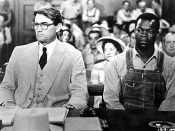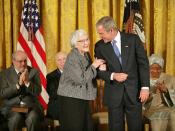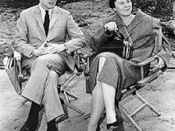Don't attack something if it hasn't harmed you. This lesson is taught to Jem and Scout by Atticus when he teaches them about the mockingbird. He says that the mockingbird is innocent and only sings for you and does nothing at all to hurt or affect mankind. It is therefore wrong to kill it...
The main example of the mockingbird within the novel is Tom Robinson. Tom was attacked by the entire white society in Maycomb County. These attacks and accusations destroyed his innocent, respectable life. The following essay analyses the trial chapters and points out how Harper Lee brings across this message to her readers.
The writer clearly states the difference between the blacks and the whites; she does this by initially telling us small details. For an example, the black people in the society live on the edge of town; this shows the readers that the blacks live on the edge, the most inferior part of Maycomb.
The way she writes shows us the moral of the story, "Shoot all the Blue jays you want if you can hit 'em, but remember it's a sin to kill a mocking bird." This moral is shown through the black people, making them the mocking birds. The trial covers many themes: The themes evidently show all forms of prejudice, and they are all conveyed in the trial. Harper Lee uses the characters of the play to show this.
Harper Lee presents to us the story of "To Kill a Mocking Bird" through the eyes of Scout Finch. The effect of doing this shows a neutral opinion of blacks and whites, if she was to view the story, say through Mayella Ewell then we would get a very one-sided story, rather then a balanced opinion that is shown through Scouts view. Scout has not been influenced by the rest of society in Maycomb, this is probably because she is so small, and is mostly influenced by her father whom is not racist. Scout shows that even though she is just a child, her judgement is not naïve as such and therefore she seems to have a better reasoning then most people in Maycomb. Another advantage of having Scout's over voice of the trial is that as she is a child, she speaks the blunt truth. Whereas having an adult's over voice would not be as affective as an adult would not be so direct and frank about the goings on in the court.
During the recess, the message that Harper Lee is trying to bring across is made more powerful. She tends to use Dill as if he was the reader. Scout and Jem incline to explain the trial to Dill and make clear to him the ways of Maycomb. Dill therefore serves the purpose of helping the reader understand the trial properly. During recess both Dill ad Scout meet Dolphus, and find out that he is not really the alcoholic that he's depicted as. Dolphus says, "I try to give them a reason see. To help folks if they can latch on to a reasonâ¦â¦It ain't honest but it's mighty helpful to folks. Secretly Miss Finch, I'm not much of a drinker but you see, they could never, never understand that I live like I do because that's the way I want to live." The activities going on inside court and that that happens during recess are linked and agree with each other. For example in Dolphus's case the people only see that he is a drunkard and pity him because of this but they do not see that he isn't. Like this the situation with Tom Robinson is parallel, the people don't see beyond his skin colour and therefore don't see his innocence.
The title of To Kill a Mockingbird has very little literal connection to the plot, but it carries a great deal of symbolic weight in the book. In this story of innocents destroyed by evil, the "mockingbird" comes to represent the idea of innocence. Thus, to kill a mockingbird is to destroy innocence. Throughout the book, a number of characters (Jem, Tom Robinson, Dill, Boo Radley, Mr. Raymond) can be identified as mockingbirds-innocents who have been injured or destroyed through contact with evil. The trial successfully captures these themes, throughout the whole book and finally is conveyed strongly and powerfully in the trial scene which is the most crucial part of the book. The morals are conveyed in an open manor which draws the attention of the reader as the trial captures interest.
The verdict of the trial therefore proves the message that Harper Lee puts forward, that in the theme of Man vs. Man the white people seem to always have a advantage over the black people. The people, even if they supported the blacks and stood up for what was right they would be known as 'nigger lovers.' Overall the story also shows how much society influences people.
I think that Harper Lee doesn't bring across only the one message which is the most important, but also a few others. She tells us in her own way that it is right to stand up for what you believe in, this message is portrayed by Atticus, the way he stood up for his beliefs also through Scout, Dill and Jem, they also stand up for what they believe in. She also tells us to never judge a person by looking at them on the outside. Like the moral to "never judge a book by its cover," Lee shows this by showing the racism in court; she makes it clear that even though all evidence points out that Tom is innocent, because of his colour he is charged anyway.
To Kill a Mockingbird tells of the gradual awakening of Scout Finch and her brother Jem. Slowly they become aware of the difference between truth and gossip, and the reader along with them, at the same pace learns that people and things are often both more and less than what they seem; that kind, easy-going neighbours can be twisted by prejudice and convention. And proved by the trial that what society did to Tom Robinson was "as shameful as killing a mockingbird."





